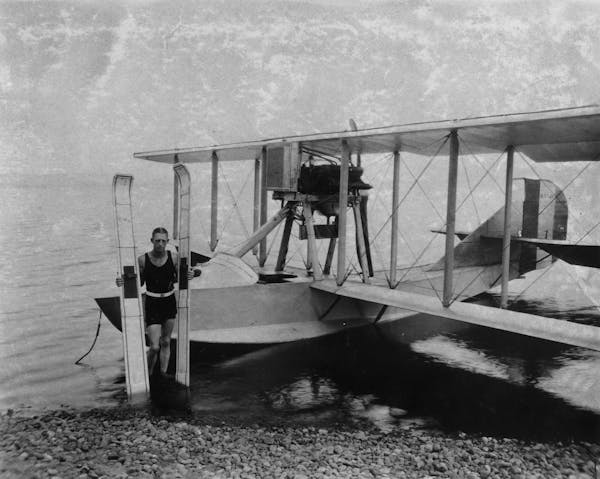Ukrainian-born Alexander Granovsky was a poet, painter, U.S. Army private during World War I and a renowned insect expert at the University of Minnesota in the mid-1900s.
He pioneered the use of chemicals to control cutworm, grubs and potato bugs, and he is credited as the first expert to call for chemically dusting forests from airplanes to curb infestations. He even has two species of the plant lice known as aphids named for him: Calaphis granovskyi and Drephanaphis granovskyi.
But Granovsky's ardent advocacy for a free and independent Ukraine might be the cornerstone of his legacy. He visited refugee camps after World War II, recruiting an estimated 5,000 displaced Ukrainian artists, scientists and carpenters to resettle in the United States — including about 100 families who wound up in Minneapolis, many in the Northeast neighborhood. He was president of the Organization for the Rebirth of Ukraine for 28 years, making him a leader among Ukrainian Americans.
Granovsky died in St. Paul on his 89th birthday in November 1976. But his words of 82 years ago about Ukraine blocking "Muscovite aggression" resonate today as the Russian invasion into his homeland drags on.
"A free Ukraine," Granovsky said in 1940, "will be the only effective buffer between the two great imperialisms, Russia and Germany, which today constitute the greatest danger to all free national states."
Halyna Myroniuk, a retired curator at the University of Minnesota Immigration History Research Center, knew Granovsky well.
"He would be very depressed by what's happening in Ukraine today and would be even more of an advocate," she said from her home in St. Paul.
Myroniuk remembers having lunch at Granovsky's home on Scudder Street near the U's St. Paul campus shortly before he died.
"He always had a youthful sparkle in his eyes and that day, over lunch, he went over the details of all the projects he still had in mind," she said. "He could be exhausting and was perpetually on the move."
The son of a farmer, Granovsky was born in what's now western Ukraine on Nov. 4, 1887. He could read in two languages by age 5 and majored in sociology and economics at an institute in Kyiv.
Though he had published poetry and short stories, Granovsky's Ukrainian patriotism prompted Russian officials to bar him from working or studying at their schools. So he immigrated to America in 1913 at 25, knowing no English.
"I pride myself that though I came to this country penniless, I did not come naked of everything," he said in 1940. "I brought a few books, a few loved pictures, a few bits of beautiful embroidery and I brought with me the cultural background of a thousand years."
Trading in his dream to be a painter, Granovsky had only $120 he made writing for Ukrainian papers when he enrolled at Colorado Agricultural College in Fort Collins, where he studied zoology and entomology. When the U.S. entered World War I in 1917, he promptly enlisted and spent nearly a year in Europe.
He returned to America after the war, serving as a high school principal in Colorado and earning his doctorate at the University of Wisconsin before joining the faculty at the University of Minnesota's Department of Entomology and Economic Zoology in 1930. He retired from the U in 1956.
In a 1940 profile in the Minneapolis Times-Tribune, writer Vivian Thorp noted that Granovsky had developed a stellar reputation during his first 10 years at the U among students and researchers.
"But he has a very bad reputation among Minnesota insect pests whose main idea is the ruination of our crops and our trees," Thorp wrote. "Grasshoppers, leafhoppers, white grubs and all their kith and kin have him catalogued as public enemy No. 1. He has become very unpopular among the aphids. … He qualifies as [a] top-notch terror to all types of pests, and glories in the distinction."
It should be noted that Granovsky advocated using the pesticide DDT to combat potato bugs — a practice banned in the U.S. in 1972 because of its adverse effects on wildlife and potential human health risks, including reproductive issues. He retired 16 years before DDT was outlawed.
Granovsky married Irene Thorpe in Sturgeon Bay, Wis., in 1928, and they raised five children. Though Irene was a member of the Daughters of the American Revolution, she enthusiastically embraced her husband's Ukrainian activism.
"I take off my hat to my wife," he said, for grasping "the significance of the struggle of downtrodden peoples."
They attended a Ukrainian Orthodox church, and collected colorful Ukrainian costumes and more than 700 decorated Easter eggs — folk art that symbolizes springtime rebirth, and a metaphor for his hopes for his homeland.
"God was too good to Ukraine," Granovsky told Thorp in 1940, "her very blessings of fertility and material wealth have betrayed her."
Curt Brown's tales about Minnesota's history appear each Sunday. Readers can send him ideas and suggestions at mnhistory@startribune.com. His latest book looks at 1918 Minnesota, when flu, war and fires converged: strib.mn/MN1918.

Civil War group honors the last Union veteran buried in each Minnesota county

St. Cloud professor's book paints nuanced look at enslaved woman freed in Minneapolis

Paying overdue tribute to his grandmother, a Minnesota farmer recarves family history

Civil War officer brought formerly enslaved family to Minnesota


